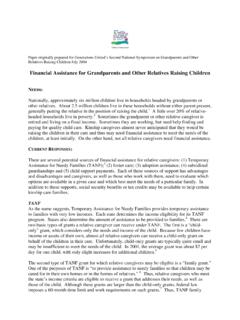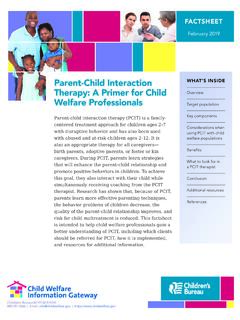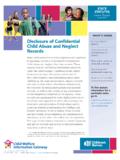Transcription of No Time to Spare
1 Office of the child and Youth AdvocateNewfoundland and Labrador December 2021No Time to SparePublished by:The Office of the child and Youth AdvocateNewfoundland and Labrador193 LeMarchant RoadSt. John s, NL A1C 2H5 Printed by:The Queen s PrinterGovernment of Newfoundland and LabradorNo Time to SpareiMessage from the child and Youth AdvocateThe title of this report No Time to Spare is a very clear message about the critical importance of timely interventions in the life of a child . Babies and young children grow and their brains develop at an incredibly fast pace.
2 This is the time and opportunity for them to develop attachments to the adults in their lives. Predictability, responsivity, and constancy are truly important. Secure attachments have a range of positive impacts on the young child , as well as into their future years. The inverse is also true where unstable relationships and lack of attachment have significant negative repercussions on a small child and create further challenges as they grow. The child who was the focus of this report was born into a trauma filled family. However, child Protection s response did not provide the positive interventions one should expect and hope.
3 I have made every effort to ensure this report does not identify this child and family. I ask that all readers respect the child s in a child s best interests requires vigilance every single day. Every decision matters. Every day matters. Every delay matters. Every child matters. Jacqueline Lake Kavanagh child and Youth AdvocateiiNo Time to SpareNo Time to SpareiiiTable of ContentsMessage from the child and Youth Advocate.
4 IIntroduction ..1 The Office of the child and Youth Advocate ..1 United Nations Convention on the Rights of the child ..1 Investigative Process ..1 Case Summary ..2 Findings and Recommendations ..3A . Placement ..3B . Case Management/Supervisory Oversight ..4 Recommendations ..6 Conclusion ..8 Appendix 1: References and Resources ..9 Appendix II: Investigative Documents and Interviews ..10No Time to SpareNo Time to Spare1 IntroductionThe Office of the child and Youth AdvocateNewfoundland and Labrador s child and Youth Advocate is an independent Statutory Officer of the House of Assembly.
5 She derives authority from the child and Youth Advocate Act. The role of the Advocate is to protect and represent the rights, interests, and viewpoints of children and youth in Newfoundland and Labrador. This is accomplished through individual advocacy, investigations and reviews, systemic advocacy, and children s rights Nations Convention on the Rights of the ChildThe Office of the child and Youth Advocate operates from a children s rights framework. Children s universal human rights are articulated in the United Nations Convention on the Rights of the child .
6 Canada ratified this Convention in 1991 with written endorsement and support from all provinces and territories. The Convention is the most universally accepted human rights framework in the world today. It speaks to the social, cultural, economic, civil, and political rights of children. Children s rights are real and meaningful. When these rights are protected and respected, they help children live better lives and have improved ProcessSection 15(1)(a) of the child and Youth Advocate Act provides the Advocate with authority to receive, review, and investigate a matter relating to a child or youth or a group of them, whether or not a request or complaint is made to the Advocate.
7 The Advocate may release a public report upon completion of an investigation. The purpose of the report is to present findings regarding the services provided to young people and to make recommendations that will help prevent similar incidents from occurring in the investigative report does not assign legal responsibilities or draw legal conclusions, nor does it replace other processes that may occur, such as investigations or prosecutions under the Criminal Code of Canada. It is intended to identify and advocate for systemic improvements and meaningful changes that will result in better responses, and enhance the overall safety and well-being of young people who are receiving designated services.
8 It is not about finding fault with specific investigative process may include interviews under oath, review of reports and documents, file reviews, policy analysis, legislative considerations, consultation with experts, examination of critical issues, research, and other factors and evidence that may arise in the course of an Time to SpareCase SummaryThis child came to the attention of the Department of Children, Seniors and Social Development (CSSD) when he was an infant. The threats to his safety included family violence, inadequate or unstable housing, as well as parental mental health and addictions concerns.
9 Both parents had been involved in the criminal justice system. While both parents were initially involved in interventions and planning, the focus eventually shifted to working with the mother only. The mother s former foster mother played a significant role in the child s care, and his biological grandmother also contributed to his care at times. CSSD engaged the mother s former foster mother as a care provider through safety plans, Family Centered Action Plans (FCAPs), child welfare Allowance (CWA) placement, kinship placement and eventually as a significant other caregiver.
10 This occurred despite uncertainty in CSSD s support for the caregiver s role. CSSD had closed the former foster mother s home previously after investigating complaints and deemed it unsuitable. The mother s relationship with her former foster mother/her son s caregiver was often contentious and a source of conflict. She believed the caregiver was alienating her child from her. She also questioned medical services and prescription drugs that the caregiver arranged for her child without her child s access to his mother became infrequent and supervised because of protection concerns.






